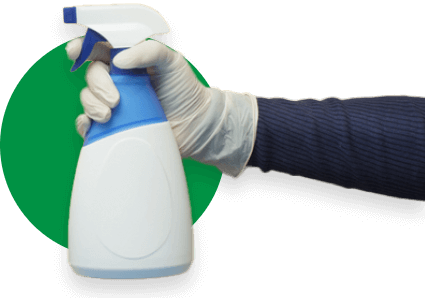Certainly, any business owner keeps a clean and tidy environment for their clientele. However, we can all agree that COVID-19 has redefined for us what “clean and tidy” means.
Vigilance and consistency are the best two tools one can utilize to ensure that your environment is a safe and clean environment for everyone, and spot cleaning and touch-ups are things you can easily maintain.
Here are a few more tips and tricks you should know.
Types of surfaces
Typically speaking, there are three kinds of surfaces that you’ll be cleaning and disinfecting:
Non-porous – Think stainless steel, stone (i.e., granite countertop), hardwood, tile, plastic, etc. If liquids won’t absorb into the material, it’s considered non-porous.
Porous – Softer surfaces such as drapes, clothing, carpeting, and upholstery. While these materials are seldom in danger of spills and stains, liquids can be more of a problem when they hit this surface.
Electronics – Electronics are their own ‘surface’ to consider because these items must be treated with special care. Plus, electronics are fomites (see the previous blog) and these devices are often hotbeds of bacterial and viral activity and should be cleaned and disinfected more often.
Best practices
Before you attack dirt and grime with an industrial-grade chemical, keep in mind a few finer points to ensure consistent and smooth cleaning protocols in your business.
Avoid deep cleaning during active hours
It’s terribly frustrating when a customer smudges up a surface you JUST cleaned, but that’s just what will happen all day every day when your regular customers come back to your establishment. For this reason, planning a cleaning schedule is crucial to maintaining a consistently clean environment. As careful or thorough as you may be, a surface is considered “dirty” as soon as someone touches it, so spot-cleaning is something you should plan to do all day long at times when it is appropriate and polite. Heavy cleaning is best left to outside business hours; of course, if a mess needs to be handled immediately, block off the area to protect passers-by from tracking the mess beyond its original site.
Pay attention to labels and warnings
It’s tempting to get the most powerful cleaner on the market, but in many cases, this can be a mistake. Industrial-grade cleaners are meant for industrial-grade messes, such as oil slicks and other toxic chemicals. If you’re only cleaning the break room, it doesn’t make sense to go nuclear.
And speaking of nuclear—even common cleaners like bleach can be toxic or harmful if mishandled. Be sure to read any instructions and warnings before you begin. For example, many chemicals need to be diluted first. If you wipe the surface with a concentrated solution, it could stain or discolor your surface unnecessarily.
Wear a mask if possible
A simple painter’s mask or similar alternative can keep you safe from the fumes produced by cleaners and disinfectants, particularly when you’re cleaning a large surface area. Even if the room is well-ventilated, it’s always a good idea to protect your mouth and nose. In some cases, eye protection can also be suitable.
Note: Try to avoid cleaners with strong scents or fragrances. Some individuals can be sensitive to smells, which can create additional problems.
Wash hard surfaces with soap and water first
It’s a common mistake for people to go straight to disinfectant when cleaning, but there are two reasons to wash the surface before using any chemicals:
First, it can remove any visible dirt and grime and in some cases, that may be enough. Second, washing will ensure that the disinfectant bonds with the whole surface-otherwise, dirty spots won’t get cleaned completely.
Electronics and porous surfaces shouldn’t be washed this way for obvious reasons. Instead, follow the instructions on the cleaner and make sure to use agents rated for that surface. For example, don’t put the carpet cleaner on a sofa, and vice versa. Finally, be sure to rinse the soap off and dry the surface thoroughly before moving onto the next step.
Let the disinfectant sit for up to 10 minutes
Yes, the label may say that the cleaner kills all germs, but not if you wipe it off immediately. Whether you spray the agent on the surface or use a wipe, be sure to let it sit. The material should be visibly damp (not wet) and you also want to avoid any pooling if possible. This ensures that all contaminants and bacteria are dead.
Rinse the surface afterward
Many individuals mistakenly believe that rinsing after disinfecting is an option, but the sticky residue left behind after cleaning will show you that it’s just not the case. This is especially true for establishments where food is consumed to prevent cross-contamination and food poisoning risks. For most surfaces, however, a spray bottle with water and a clean towel should suffice for this step.
Clean high-traffic surfaces daily (at least)
If you haven’t cleaned your computer keyboard in a while, you probably DON’T want to know how many living germs are currently there as you read this. You’d be amazed by how some of the most common household items are the filthiest, dirtiest fomites you encounter each day, simply because they’re forgotten. Any surface that gets touched a lot, either by one or many individuals, must be cleaned as frequently as possible. Ideally, you can wipe these surfaces down multiple times per day—if not, daily cleaning and disinfectant can help prevent the spread of germs and diseases.
Call Dallas Janitorial Services Today
We trust you can handle the daily spot cleaning around the shop or in the office, but the deep cleaning requires knowledge, experience, commitment and professionalism. No matter what kind of surfaces or rooms you have, Dallas Janitorial Services can ensure your comfort in cleanliness from top to bottom. Call us to learn more about our services and set up a maintenance schedule.


